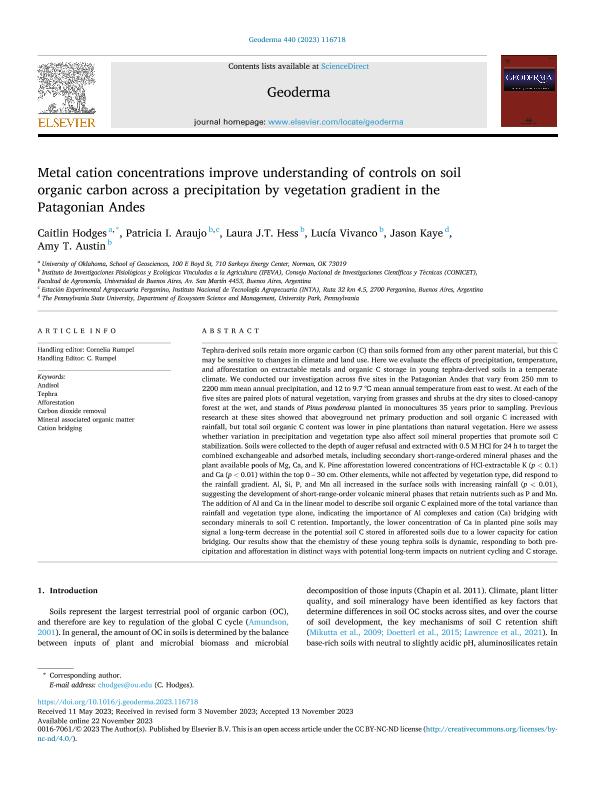Mostrar el registro sencillo del ítem
dc.contributor.author
Hodges, Caitlin
dc.contributor.author
Araujo, Patricia Inés

dc.contributor.author
Hess, Laura J. T.
dc.contributor.author
Vivanco, Lucía

dc.contributor.author
Kaye, Jason
dc.contributor.author
Austin, Amy Theresa

dc.date.available
2023-12-21T17:53:46Z
dc.date.issued
2023-12
dc.identifier.citation
Hodges, Caitlin; Araujo, Patricia Inés; Hess, Laura J. T.; Vivanco, Lucía; Kaye, Jason; et al.; Metal cation concentrations improve understanding of controls on soil organic carbon across a precipitation by vegetation gradient in the Patagonian Andes; Elsevier Science; Geoderma; 440; 12-2023; 1-10
dc.identifier.issn
0016-7061
dc.identifier.uri
http://hdl.handle.net/11336/221188
dc.description.abstract
Tephra-derived soils retain more organic carbon (C) than soils formed from any other parent material, but this C may be sensitive to changes in climate and land use. Here we evaluate the effects of precipitation, temperature, and afforestation on extractable metals and organic C storage in young tephra-derived soils in a temperate climate. We conducted our investigation across five sites in the Patagonian Andes that vary from 250 mm to 2200 mm mean annual precipitation, and 12 to 9.7 ℃ mean annual temperature from east to west. At each of the five sites are paired plots of natural vegetation, varying from grasses and shrubs at the dry sites to closed-canopy forest at the wet, and stands of Pinus ponderosa planted in monocultures 35 years prior to sampling. Previous research at these sites showed that aboveground net primary production and soil organic C increased with rainfall, but total soil organic C content was lower in pine plantations than natural vegetation. Here we assess whether variation in precipitation and vegetation type also affect soil mineral properties that promote soil C stabilization. Soils were collected to the depth of auger refusal and extracted with 0.5 M HCl for 24 h to target the combined exchangeable and adsorbed metals, including secondary short-range-ordered mineral phases and the plant available pools of Mg, Ca, and K. Pine afforestation lowered concentrations of HCl-extractable K (p < 0.1) and Ca (p < 0.01) within the top 0 – 30 cm. Other elements, while not affected by vegetation type, did respond to the rainfall gradient. Al, Si, P, and Mn all increased in the surface soils with increasing rainfall (p < 0.01), suggesting the development of short-range-order volcanic mineral phases that retain nutrients such as P and Mn. The addition of Al and Ca in the linear model to describe soil organic C explained more of the total variance than rainfall and vegetation type alone, indicating the importance of Al complexes and cation (Ca) bridging with secondary minerals to soil C retention. Importantly, the lower concentration of Ca in planted pine soils may signal a long-term decrease in the potential soil C stored in afforested soils due to a lower capacity for cation bridging. Our results show that the chemistry of these young tephra soils is dynamic, responding to both precipitation and afforestation in distinct ways with potential long-term impacts on nutrient cycling and C storage.
dc.format
application/pdf
dc.language.iso
eng
dc.publisher
Elsevier Science

dc.rights
info:eu-repo/semantics/openAccess
dc.rights.uri
https://creativecommons.org/licenses/by-nc-nd/2.5/ar/
dc.subject
AFFORESTATION
dc.subject
ANDISOL
dc.subject
CARBON DIOXIDE REMOVAL
dc.subject
CATION BRIDGING
dc.subject
MINERAL ASSOCIATED ORGANIC MATTER
dc.subject
TEPHRA
dc.subject.classification
Ecología

dc.subject.classification
Ciencias Biológicas

dc.subject.classification
CIENCIAS NATURALES Y EXACTAS

dc.title
Metal cation concentrations improve understanding of controls on soil organic carbon across a precipitation by vegetation gradient in the Patagonian Andes
dc.type
info:eu-repo/semantics/article
dc.type
info:ar-repo/semantics/artículo
dc.type
info:eu-repo/semantics/publishedVersion
dc.date.updated
2023-12-21T11:24:50Z
dc.journal.volume
440
dc.journal.pagination
1-10
dc.journal.pais
Países Bajos

dc.journal.ciudad
Amsterdam
dc.description.fil
Fil: Hodges, Caitlin. Oklahoma State University; Estados Unidos
dc.description.fil
Fil: Araujo, Patricia Inés. Consejo Nacional de Investigaciones Científicas y Técnicas. Oficina de Coordinación Administrativa Parque Centenario. Instituto de Investigaciones Fisiológicas y Ecológicas Vinculadas a la Agricultura. Universidad de Buenos Aires. Facultad de Agronomía. Instituto de Investigaciones Fisiológicas y Ecológicas Vinculadas a la Agricultura; Argentina. Instituto Nacional de Tecnología Agropecuaria. Centro Regional Buenos Aires Norte. Estación Experimental Agropecuaria Pergamino; Argentina
dc.description.fil
Fil: Hess, Laura J. T.. Consejo Nacional de Investigaciones Científicas y Técnicas. Oficina de Coordinación Administrativa Parque Centenario. Instituto de Investigaciones Fisiológicas y Ecológicas Vinculadas a la Agricultura. Universidad de Buenos Aires. Facultad de Agronomía. Instituto de Investigaciones Fisiológicas y Ecológicas Vinculadas a la Agricultura; Argentina
dc.description.fil
Fil: Vivanco, Lucía. Consejo Nacional de Investigaciones Científicas y Técnicas. Oficina de Coordinación Administrativa Parque Centenario. Instituto de Investigaciones Fisiológicas y Ecológicas Vinculadas a la Agricultura. Universidad de Buenos Aires. Facultad de Agronomía. Instituto de Investigaciones Fisiológicas y Ecológicas Vinculadas a la Agricultura; Argentina
dc.description.fil
Fil: Kaye, Jason. State University of Pennsylvania; Estados Unidos
dc.description.fil
Fil: Austin, Amy Theresa. Consejo Nacional de Investigaciones Científicas y Técnicas. Oficina de Coordinación Administrativa Parque Centenario. Instituto de Investigaciones Fisiológicas y Ecológicas Vinculadas a la Agricultura. Universidad de Buenos Aires. Facultad de Agronomía. Instituto de Investigaciones Fisiológicas y Ecológicas Vinculadas a la Agricultura; Argentina
dc.journal.title
Geoderma

dc.relation.alternativeid
info:eu-repo/semantics/altIdentifier/doi/http://dx.doi.org/10.1016/j.geoderma.2023.116718
Archivos asociados
